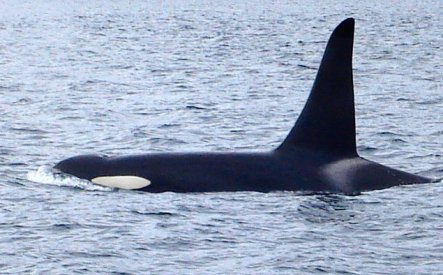This essay is an excerpt from the forthcoming book Thousand Mile Song: Whale Music in a Sea of Sound
(http://www.thousandmilesong.com). To hear David Rothenberg’s live jazz duets
with whales, visit the CD Baby page for his new CD, Whale Music
(http://cdbaby.com/cd/davidrothenberg2).
[Terra Nova] •
Can
humans make live music together with whales?
Modern technology brought us the whale song, and it can send our music
down into their depths. You already know
that hydrophones can record the strange behavior of sound under water, but
here’s the rest of how it’s done: Sit on
the deck of a boat, or on shore if the water adjacent is deep enough to welcome
whales. Play your instrument, say a
clarinet, into a small microphone on a stand.
Plug that microphone into a preamp.
Send the output to a small battery-powered amplifier. Send the output of that amplifier to an
underwater speaker, something that used to be expensive but is now of course
cheaply available from China. [i] Send that clarinet sound deep underwater,
where even with low power it can travel quite far. Record the output from the hydrophone and you
will hear your underwater self, along with any whales that happen to be
singing.
It’s not as easy as
jamming with birds, because I will not usually be able to see who I’m singing
with. I’ll play by ear, and whatever
music I make with the whales will not sound entirely human. Some whale sounds
are so low or so high that we cannot hear them.
Reaching beyond species lines always means extending the boundaries of
what counts as music. You will hear
things that surprise you, and play sounds that you would never play otherwise. A strange beauty emerges even if the message
cannot be decoded.
After dolphins,
the whales we know best are orcas, or killer whales, so named because they will
attack and eat almost anything that lives in the sea. But they also have a gentle side. They’re
curious about people, and for decades whale watchers, scientists, and musicians
have felt a special connection with these animals. Some have been watched so closely in the
waters surrounding Vancouver Island that each individual
whale is known by name, family, and lineage.
The whales can be identified by their unique tail and fin patterns, and
since they are black and white, they are much easier to see than any other
whale species. Orcas are social animals
and use sound to keep the pod together as they zoom through the sea. They use song in a way that more closely
resembles the laughing thrush than the humpback whale. The guidebooks published to help visitors
identify each whale emphasize their appearance, but the original difference
between pods and clans of orcas was discovered through sound; first by listening,
and later by interacting with them.
Who
has played music to killer whales? Paul
Winter, for all the great photos of him and his soprano sax standing in rafts
playing pure tones out to leaping orcas, says he just tried it once, thirty
years ago, blowing the sax into a big metal tube that stuck into the
water. He heard the whales, the whales
heard him. “At one point it seemed like
they were responding,” he says, but this live interaction never made it onto
his records the way the sax/wolf duets did.
A
few scientists in the sixties and seventies played music to orcas, but they
don’t much like to talk about it today-seems a bit “new agey” by today’s
standards of rigor, or at least beyond the limits of experimental control. Paul Spong, the guardian of the orcas of North
Vancouver Island, and leader of several decades of research into
their habits and behavior, began his work on the sensory systems of orcas at
the Vancouver Aquarium in the mid-1960s.
Getting food in exchange for tricks did not interest the captive whales,
so Spong tried playing a whale back a tape of his own sounds. Not interested. He tried the sound of another whale. A faint glimmer of curiosity, but that didn’t
last. The aquarium whales seemed
bored. Spong wanted to make the whales
happier in their confinement, and got interested in what animal trainers call enrichment, making the lives of their
charges just a bit more interesting.
When a whale named
Haida lost his mate, he sat despondent in the pool as if she too wanted to die,
refusing to eat anything for a month.
Spong invited jazz flutist Paul Horn, known for his solo recordings
inside the Great Pyramid and in the Taj Mahal, to offer some gentle music to
cheer up the bereaved whale. For a week
he played mournful elegies for the whale’s lost love, but Haida showed no
interest. One of the trainers urged Horn
to try a more positive approach.
“I get the feeling
you are playing rather sad music,” she said, “reinforcing Haida’s
unhappiness. Maybe you should try
providing some positive energy to bring him out of his depression.”
Horn leaned over
the water and talked to Haida eye to eye:
“Look, I’ve been coming here for three days now and you have totally
ignored me. I get no response from you,
and I’m getting bugged.”[ii]
The whale said nothing. Horn continued. “We know you’ve suffered a great loss, and we
sympathize with you. But thousands of
people come to see you, they respect and admire you, but you’re letting
yourself down. Not only that, you are
letting yourself down and you’re letting life down. Life is a very precious thing, Haida, so get
your act together and snap out of it.
I’ll come back one more time. If
you don’t respond tomorrow, then I won’t come back again.”
The next day Paul
Horn was back at the pool, playing the same mournful music he always
played. But right away Haida moved his
head, the first movement he’d made in weeks.
Horn walked around the pool, playing his flute with conviction, just
like he’d famously done walking around the Taj Mahal. For the rest of that week the whale followed
the flutist, and after five days, Paul put his flute down and dangled a herring
over the water. Haida hesitated a
moment, but then decided to scarf it down.
It was the first food he had taken in a month, and the first time a whale
was known to have been brought out of depression through music therapy.
Haida recovered
enough to be brought a new mate from another oceanarium. The next time Paul came to play, the female
whale seemed more interested in the music than Haida, who disappeared to the
other end of the pool. After a few
minutes hiding deep down, he suddenly leaped out of the water at high speed and
smacked down on the water as hard as he could, spraying a huge wave all over
Horn and his precious flute. “It seemed
clear he was either jealous of me or annoyed that his girlfriend was more
interested in the flute than she was in him.
Whatever the reason, he was pissed off and got me soaking wet. This was the last time I saw Haida.” Music later became part of the general enrichment
program for captive whales all over the world.
But Paul Spong was
not satisfied. He had grown confident
enough to touch the huge beasts. A whale
named Skana seemed to enjoy being touched and rubbed, especially by Spong’s bare
feet. One morning her behavior
changed. Spong was sitting with his feet
in the water of the pool. Skana
approached very cautiously, then opened her mouth wide and dragged her teeth
quickly across the top of his feet. He
pulled his toes out as quickly as he could.
After a moment, he put his feet back in.
The whale came back, again flashing her teeth. The feet came out again in an instant. They did this many times in a row, until
finally Spong was able to control the urge to flinch. When he stopped reacting,
Skana stopped with the teeth.
Spong’s attitude
to these animals suddenly changed. It
seemed to him they were conducting their own experiments on him. [iii] How could he condone keeping animals with
such intelligence in captivity? Much of
what we have learned about whale bodies and brains could only be found out with
captive animals, but Spong could do this work no longer. The more he learned of these animals, the
more he wanted to offer them freedom. He
made preparations to leave the aquarium.
He believed the whales should be in the wild, and so should he.
In 1970 Spong
headed to Johnstone Strait
to set up a field center for the study of wild killer whales. It is still going strong on Hansen
Island at the end of the strait,
the longest continuously running whale field research center in the world. Since these animals live so close to human
habitation in clear social groups, they are much easier to study than the
humpbacks who migrate far across wide oceans, who have the longer, more epic
songs. But orca songs are equally
interesting because they are so interactive-these
whales use a distinct sonic repertoire to stay in constant communication with each other. So it’s more likely that a killer whale will
respond to a new human sound than the staid, solo performing humpbacks.
In
the beginning, Spong played all kinds of recorded human music through
underwater speakers to see if the wild, free-ranging orcas showed any interest
like their cousins in captivity. They
didn’t seem to care. Then, he tried live
music, with a Vancouver rock band called Fireweed jamming from a fifty-foot
sailboat. One pod assembled around the
boat and followed along for several miles, something that hardly ever happened. The younger whales especially seemed to have
an ear for rock and roll, and stayed close to the boat as long as the music was
blaring.
The
next summer Spong wanted to get closer.
He took a solo kayak out to be in the midst of the pod, and, perhaps
inspired by Horn, brought along a wooden flute.
Playing soft tones above water, he sensed the whales could hear the
sound under the surface, even though he couldn’t hear them. After building a sense of trust with the
orcas, he began to swim and dive among them.
In Mind In the Waters, Spong
writes his most moving words on why music must matter to killer whales: “Sometimes, particularly on a still night, a
pod or part of a pod, or perhaps just a single whale, will hover offshore for
an hour or more, apparently tuning in to the music. Sometimes they seem to join in the celebration
with the chorus of their voices and the dance of their bodies, visible to us
from the bubbling phosphorescent wakes they leave behind. [iv]
Others
were drawn to the area by such testimony.
Erich Hoyt came to Johnstone
Strait in 1973 to make one of the first documentary films about
orcas. He got a hold of some of Spong’s
tapes of orca whistles, and started learning the repertoire on his Arp Odyssey
synthesizer, an early electronic analog instrument the size of a portmanteau
suitcase with a several octave keyboard and about forty sliders. It was particularly adept at making loud,
strange whoops and pure sine-tone whistles.
Hoyt moved the faders up and down, twiddling knobs,
adjusting timbres. When he first got out
in the field to hear the actual whales, he felt he was in the hall of nature
listening to a grand new piece: “I’ve
just walked into the opera house, I have no program. Strange new players are premiering a piece by
a flamboyant new composer.” [v] Swelling, dischordant strings morphing into
rusty saxophones. Pizzicato
trumpets? Impossible echoes? The reverberations carried for miles.
Hoyt sat at the Odyssey’s controls, waiting for his
cue. Suddenly he heard a familiar
phrase, one he thought came from a whale named Wavy he had heard a few days
before. Other whales answered the same
phrase, always with slight variation.
The accent switched from the first to the third note. It was an ensemble piece, with hardly any
space for him. Finally the moment came,
he played the phrase he had prepared, but he changed the beat just a bit. A few seconds, then he heard it, “A perfect
imitation of what I had just played to them–in harmony! They did not repeat their own sound; rather,
they duplicated my human accent.” The
first time was the best time. When Hoyt
repeated his experiment, the whales had lost interest. Perhaps they don’t care that much for our
music after all.
Almost as quickly as it sprang up, the idea of playing
music to orcas began to fade away. As
Spong became more of a scientist, and Hoyt became more of an activist, they
were cautioned by their peers against doing things so risqué as jamming along
with whales. It didn’t look like serious work. It wasn’t research, because it
was never done in a controlled manner.
Animal behavior science is hard enough to control as it is, and with
music in the mix, could a scientist be taken seriously? The standards of whale science were getting
more rigorous, especially as the formerly flourishing orcas became increasingly
threatened, even in the apparently pristine environment of Johnstone
Strait. Shipping traffic was increasing,
pollution was on the rise, loggers would
happily clearcut every one of these verdant islands. It was time to focus on conservation.
Both these guys worked hard to set up marine sanctuaries
for these animals, Spong putting roots down on Hansen Island, Hoyt working all
over the world to save the whales. The
two men have remained committed to the cause more than anyone. But in the beginning they were both motivated
by simple wonder. As Spong puts it, “The
whales sang and called to us and we returned their voices with everything we
could manage-flute sounds, imitation orca sounds, singing and laughing-in the
joy that only free creatures and free people can create together.”[vi]
Photo by Alanna@VanIsle, courtesy Creative Commons license.
[i] Now available cheaply from China:
You can get reasonable underwater speakers from www.esunpride.com
[ii] I get no response from you and I’m getting bugged“:
Paul Horn, Inside Paul Horn (San
Francisco: Harper Collins, 1990), p. 179.
[iii] The whales were conducting their own experiments on him: Erich Hoyt, Orca: The Whale Called Killer,
(Tonawanda, NY: Firefly Books, 1990), p. 43.
[iv] Sometimes they seem to join in the celebration”: Paul Spong, “The Whale Show,”
in Joan McIntyre, ed. Mind in the Waters (New
York: Scrinbner’s, 1974), p. 180.
[v] I’ve just walked into the opera house, I have no program”: Erich Hoyt, Orca, p. 53.
[iv] “The joy that only free creatures and free people can create together”: Paul
Spong, Ibid, p. 185.













